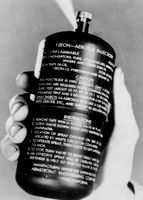








Aerosol spray is a type of dispensing system which creates an aerosol mist of liquid particles.
The concepts of aerosol probably go as far back as 1790.The first aerosol spray can patent was granted in Oslo in 1926 to Erik Rotheim, a Norwegian chemical engineer,and a United States patent was granted for the invention in 1931.The patent rights were sold to a United States company for 100,000 Norwegian kroner.The Norwegian Postal Service, Posten Norge, celebrated the invention by issuing a stamp in 1998.
In 1939, American Julian S. Kahn received a patent for a disposable spray can,but the product remained largely undeveloped. Kahn's idea was to mix cream and a propellant from two sources to make whipped cream at home — not a true aerosol in that sense. Moreover, in 1949, he disclaimed his first four claims, which were the foundation of his following patent claims. It was not until 1941 that the aerosol spray can was first put to good use by Americans Lyle Goodhue and William Sullivan, who are credited as the inventors of the modern spray can.Their design of a refillable spray can dubbed the "bug bomb", is the ancestor of many popular commercial spray products. Pressurized by liquefied gas, which gave it propellant qualities, the small, portable can enabled soldiers to defend against malaria-carrying mosquitoes by spraying inside tents and airplanes in the Pacific during World War II.Goodhue and Sullivan received the first Erik Rotheim Gold Medal from the Federation of European Aerosol Associations on August 28, 1970 in Oslo, Norway in recognition of their early patents and subsequent pioneering work with aerosols. In 1948, three companies were granted licenses by the United States government to manufacture aerosols. Two of the three companies, Chase Products Company and Claire Manufacturing, still manufacture aerosols to this day. The "crimp-on valve", used to control the spray in low-pressure aerosols was developed in 1949 by Bronx machine shop proprietor Robert H. Abplanalp.